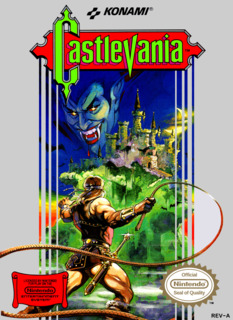The original Castlevania may not be the best of all early NES games, but it ranks up there.
Castlevania has an interesting if not overly complex plot for an NES game of the era: the player takes on the role of Simon Belmont, famed demon slayer of Middle Ages-era Europe, who has been tasked with defeating the infamous vampire Dracula himself, and of all places on Dracula's turf - his very castle. An interesting added twist was that the game was presented as occurring in a movie as evidenced by the film reel style of the intro screen, although this film element does not factor in heavily into the game's overall presentation. This movie presentation, along with its castle combat environment, have become the defining hallmarks of the Castlevania series. As Simon inches closer to Dracula's lair, he'll have to battle zombies, walking skeletons, possessed suits of armor, flying Medusa heads and a whole host of iconic monster types. Additionally, Simon will have to dodge and deal with the various traps and obstacles spread around Dracula's castle, blending traditional action and platformer elements together.
Gameplay is straightforward and Simon can perform a few basic, useful moves such as jump, attack with his whip, and use secondary weapons. Most secondary weapons are designed to be thrown and extend the range of the player's attack - knives, axes, cross-shaped boomerangs, and Holy Water which causes an area damage effect. Additionally, a watch allows the player to freeze all enemies on-screen for a few seconds, particularly useful during moving platform jumping. Although there are only relatively few levels to transverse, the game presents a very challenging experience especially when it comes time to confront the mobile level bosses. Fortunately, the game allows the player to continue at the beginning of the level for an infinite number of tries rather than returning the player to the beginning of the entire game once all of his extra lives have been expended, easing much of the frustration. On the other hand, jumping actions can be performed somewhat smoother as being able to leap across crevasses is an integral part of the game, but it's not wholly detrimental to the game experience.
Graphics are not exactly stunning, even for an early NES game, but are still very much above average. The game's graphical presentation goes a long way towards immersing the player into its old school, horror movie-like castle environment and features richly detailed backgrounds: molding castle walls, chipped stones and crumbling catwalks. Underground levels are also done equally richly and lend itself to portraying the proper atmosphere. Accompanying the graphical presentation is the excellent midi score which brings the atmosphere of the game the rest of the way, particularly during boss stages. Sound effects are few but effective, and the lack of them ensures little interruption of the game's musical score.
Overall, Castlevania is an excellent game, especially for an early NES game. Its innovative blending of traditional action and platformer elements works well with the old school horror setting, and the environmental presentations complete the experience. With these factors into play it becomes little wonder as to how this game took off to become the gaming franchise it is today.

